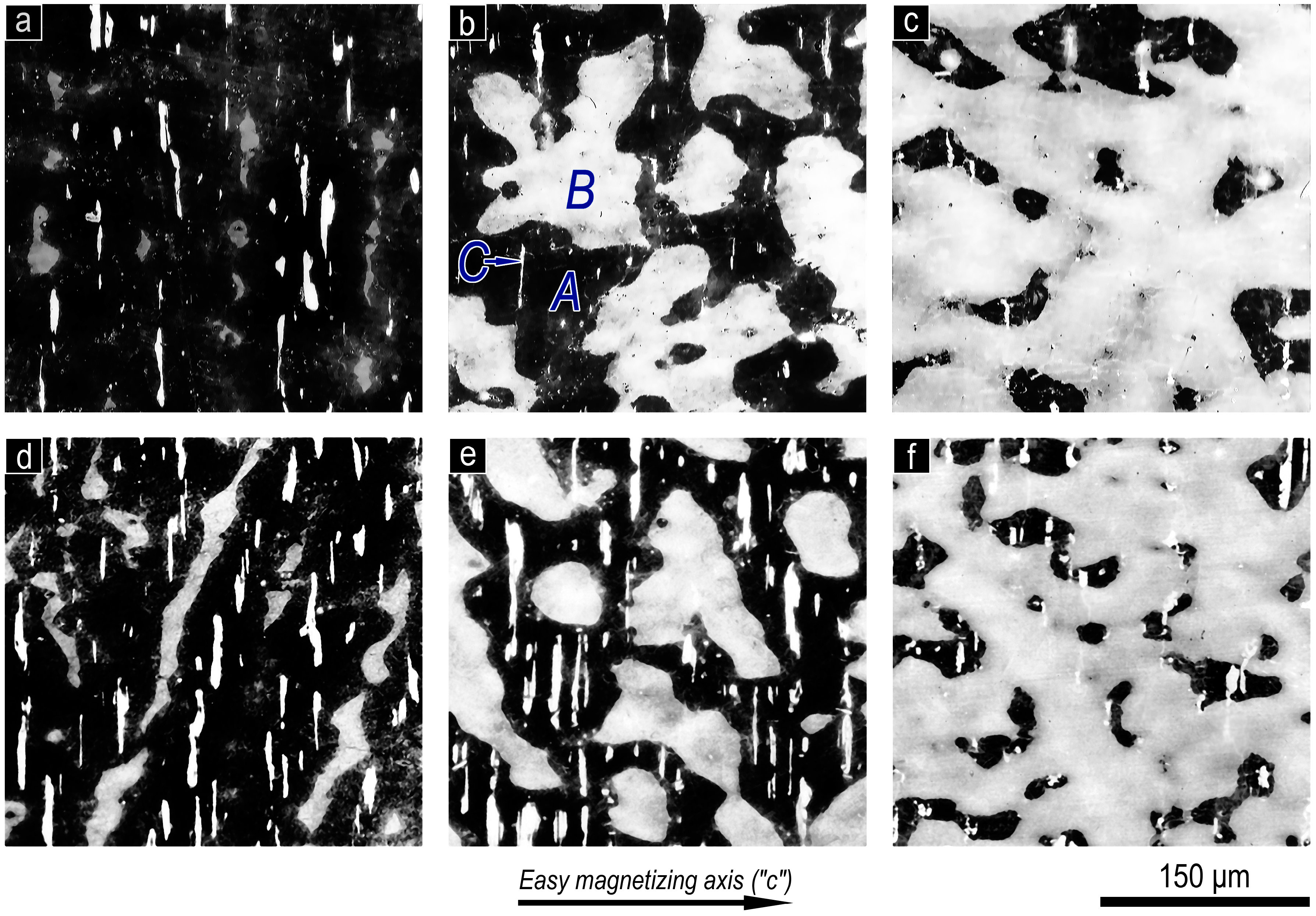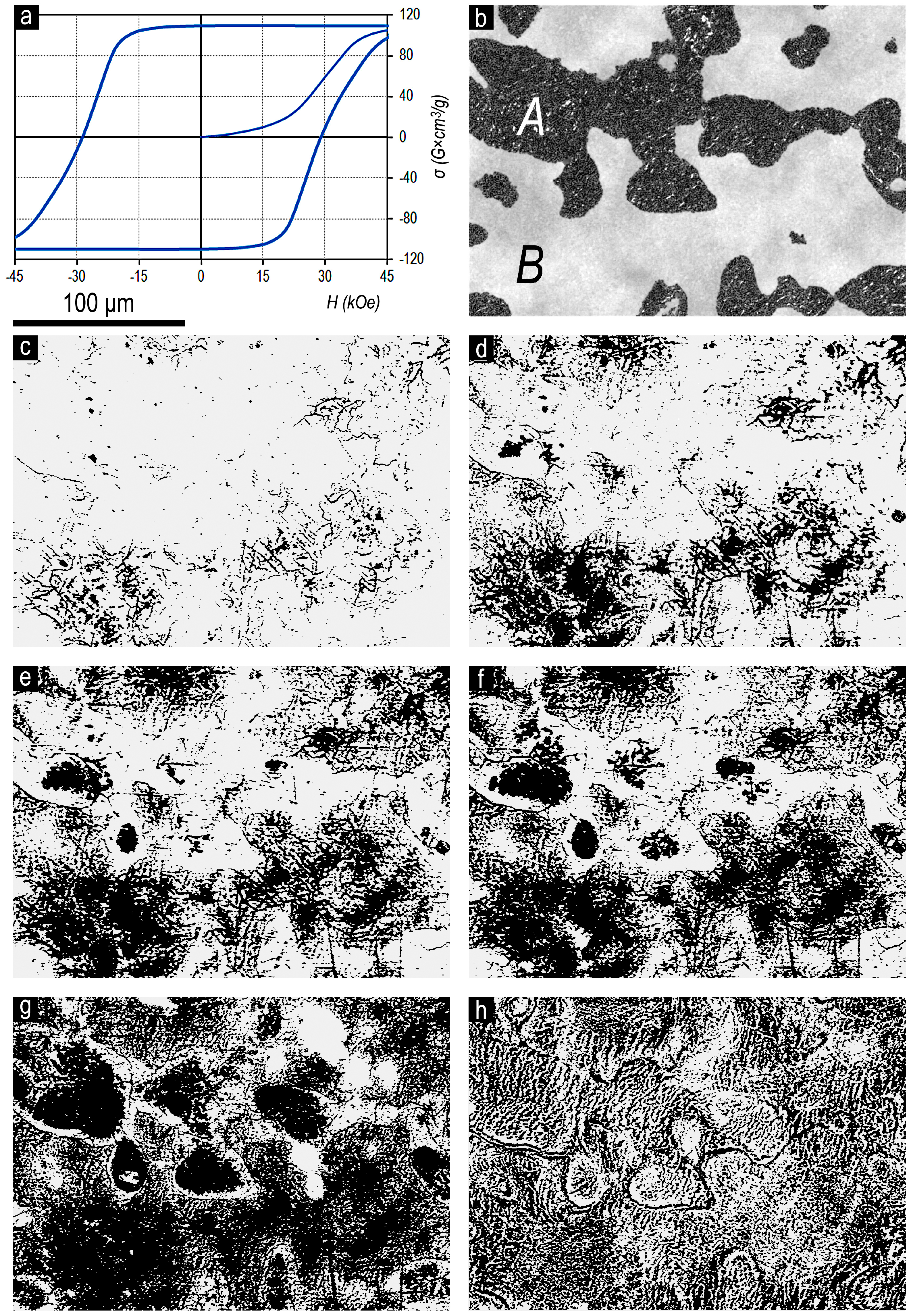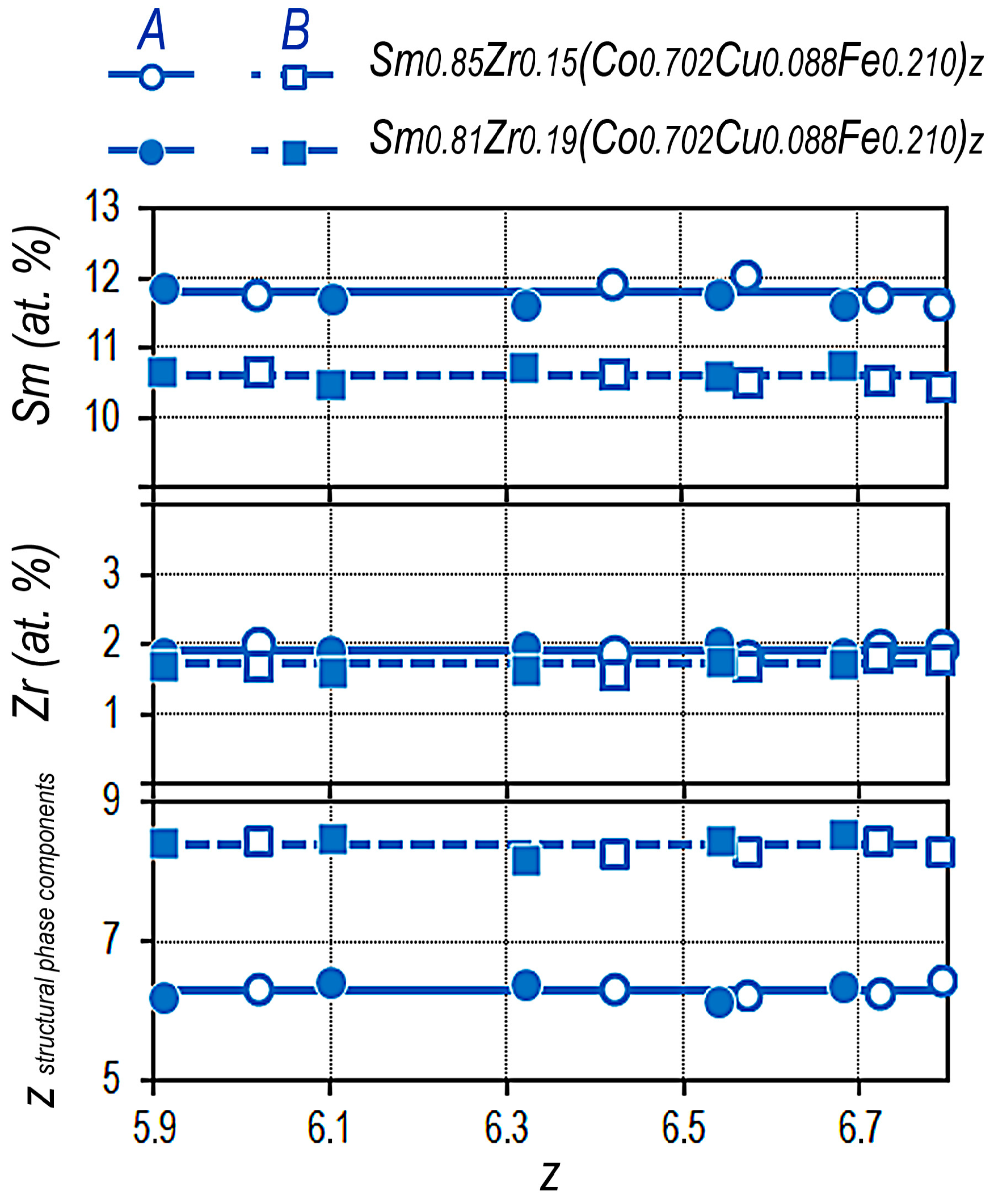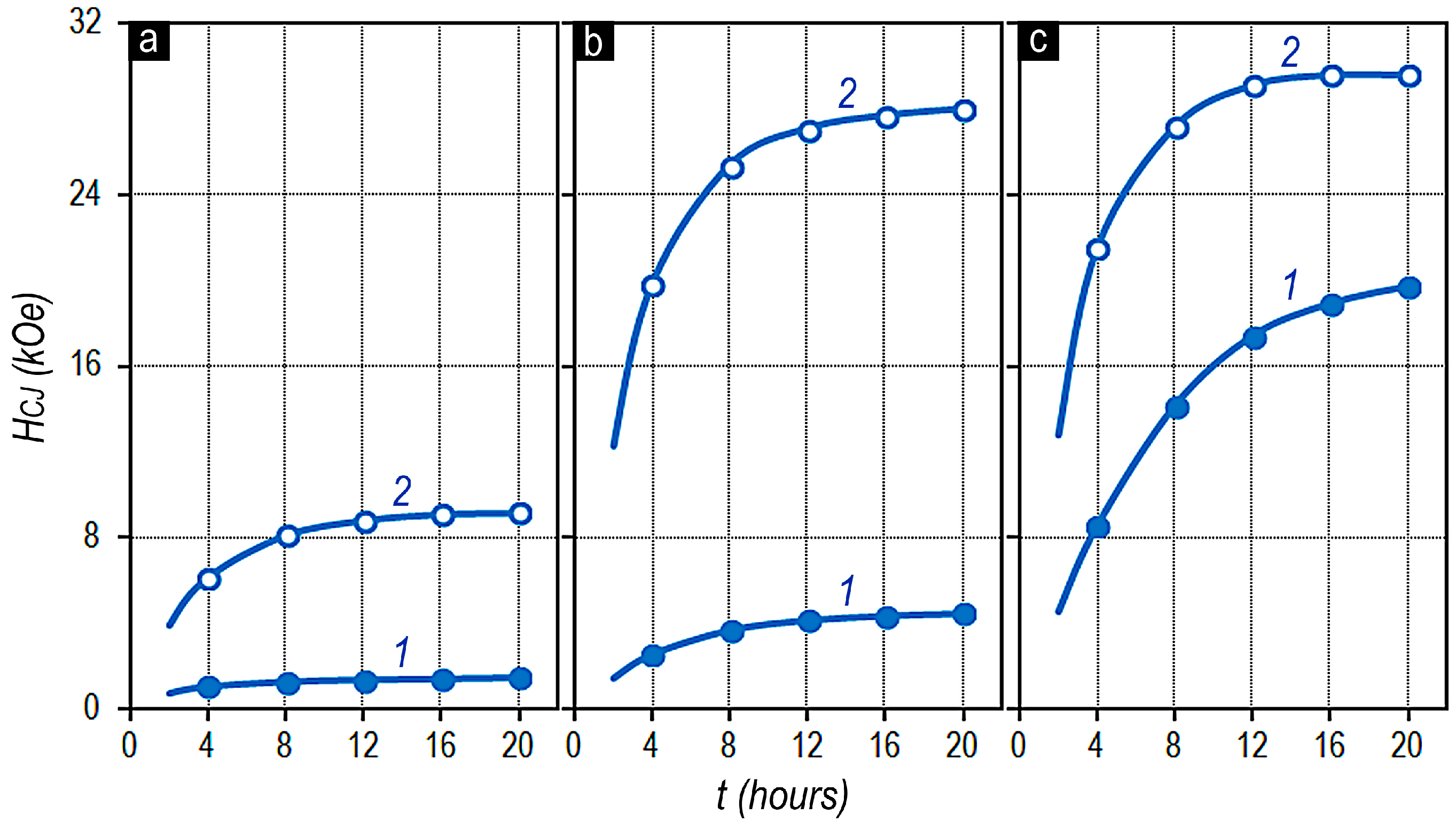Structure of Alloys for (Sm,Zr)(Co,Cu,Fe)z Permanent Magnets: II. Composition, Magnetization Reversal, and Magnetic Hardening of Main Structural Components
Abstract
1. Introduction
- Samples prepared from single grain of alloy ingot are not single crystals because of their heterophase structure. However, taking into account the collinearity of all phases comprising the samples (with the common easy magnetization axis), we call them pseudo-single-crystal samples (from here in, samples).
- We call the hysteresis loops of samples comprising an individual experimental series ultimate hysteresis loops if, during magnetic measurements, at least some samples of this series exhibit the value of (BH)MAX equal to (4πJS)2/4.
- the magnetization reversal processes of two base structural components A and B;
- the chemical composition of components A and B in samples in the high-coercivity state, the composition ranges of which ensure changing the volume fractions of these components within wide ranges;
- the peculiarities of the magnetic hardening of samples at different stages of thermal aging in accordance with the relationship of volume fractions of structural components A and B.
2. Materials and Methods
3. Results
3.1. Peculiarities of Magnetization Reversal of Main Structural Components of (Sm,Zr)(Co,Cu,Fe)z Alloys in the High-Coercivity State
3.2. Composition Peculiarities of Structural Components of (Sm,Zr)(Co,Cu,Fe)z Alloy Samples in the High-Coercivity State
3.3. Effect of the Relationship of Main Structural Components A and B on the Magnetic Hardening of the (Sm,Zr)(Co,Cu,Fe)z Alloys during Heat Treatment
3.4. Effect of Relationships of Volume Fractions of Main Structural Components A and B on the Temperature Dependences of the Coercive Force (HCJ) of (Sm,Zr)(Co,Cu,Fe)z Alloy Samples in the High Coercivity State
4. Discussion
- -
- the same level of concentrations of main elements in the integral composition of the alloy after solid solution heat treatment;
- -
- directional diffusion of elements between structural components formed based on different phases;
- -
- wide ranges of variations of the volume fractions of components A and B in accordance with z of alloy.
5. Conclusions
- The heat treatment for the high-coercivity state leads to the substantial separation of two main structural components (A and B) in the chemical composition; the separation is caused by different temperature dependencies of the solubility of 3d elements in the phases being the basis for these structural components (1:5 and 2:17, respectively).
- The separation of the structural components in the chemical composition predetermines the formation of different domain-wall pinning centers (thin phase structure), which determines qualitative and quantitative differences in the development of surface domain structures in structural components A and B upon magnetization reversal.
- The surface domain structure of component B is the network of reverse zigzagging submicron-thick domains, which arise from numerous centers. As the magnetization reversing magnetic field increases, the magnetization reversal of B occurs at the expense of appearance of new domains that progressively fill the reverse-domain network rather than increasing the thickness of the domains.
- The surface domain structure of component A is analogous to that of Sm(Co,Cu,)x and Sm(Co,Cu,Fe)x alloy samples (x = 5–6). Its development upon magnetization reversal occurs from a limited number of centers at the expense of the formation of reverse labyrinth domains, which transfer into fern-like domains growing isotropically in all directions.
- The domain structure of component B in the pseudo-single-crystal samples indicates that the morphology of its fine phase structure is identical to the structure of sintered (Sm,Zr)(Co,Cu,Fe)z magnets, which comprises cellular, boundary, and plate-like phases. In turn, the phase structure of component A is the model prototype of the boundary phase in sintered magnets.
- There is direct interrelation between the chemical composition of samples, relationship of volume fractions of main components (A and B) in the structure of samples, and development of the coercive force as a result of magnetic hardening upon isothermal aging followed by quenching or upon isothermal and stepped heat treatments.
- The cellular morphology in the alloy structure is formed in the course of isothermal aging, whereas the final phase compositions of component A and boundary phase B are formed in a temperature range from isothermal aging temperature to 400 °C upon stepped (slow) cooling or quenching.
- The propensity of chemical compositions of component A and component’s B boundary to phase transformations after the completion of isothermal aging (quenching or stepped aging) and degree of completion of these transformations directly depend on the relationship of volume fractions of component A and B and the (4f-,4d-)/(3d-) element ratio (i.e., z) in the (Sm,Zr)(Co,Cu,Fe)z alloy. In turn, the degree of completion of phase transformations determines the final hysteretic properties of samples.
- The viewpoint that the formation of the final phase composition in the (Sm,Zr)(Co,Cu,Fe)z alloy occurs only in the course of isothermal stage of heat treatment and that phase transformations are absent at the stage of stepped aging (or slow cooling) is inaccurate.
Author Contributions
Funding
Acknowledgments
Conflicts of Interest
References
- Xu, C.; Wang, H.; Zhang, T.-L.; Popov, A.; Gopalan, R.; Jiang, C.-B. Correlation of microstructure and magnetic properties in Sm(CobalFe0.1Cu0.1Zr0.033)6.93 magnets solution-treated at different temperatures. Rare Met. 2019, 38, 20–28. [Google Scholar] [CrossRef]
- Shang, Z.F.; Zhang, D.T.; Altounian, Z.; Xie, Z.H.; Qiao, P.B.; Liu, W.Q.; Wang, Y.Q.; Yue, M. Effect of ingot cooling rate on Cu distribution and magnetic properties of Sm(CobalFe0.28Cu0.07Zr0.03)7.6 magnets. AIP Adv. 2019, 9, 125142. [Google Scholar] [CrossRef]
- Machida, H.; Fujiwara, T.; Fujimoto, C.; Kanamori, Y.; Sakakura, K.; Takezawa, M. Magnetic properties and microstructures of high heat-resistance Sm-Co magnets with high Fe and low Zr content. AIP Adv. 2019, 9, 125042. [Google Scholar] [CrossRef]
- Dospial, M.M.; Nabialek, M.; Szota, M.; Plusa, D. The magnetization reversal processes of Sm2Gd10.5Fe8Co64Zr2.5Cu13 alloy in the as-quenched state. J. Alloys Compd. 2011, 509, S404–S407. [Google Scholar] [CrossRef]
- Dormidontov, A.G.; Kolchugina, N.B.; Dormidontov, N.A.; Milov, Y.V. Structure of Alloys for (Sm,Zr)(Co,Cu,Fe)Z Permanent Magnets: First Level of Heterogeneity. Materials 2020, 13, 3893. [Google Scholar] [CrossRef] [PubMed]
- Strnat, K.J. Rare Earth Cobalt Permanent Magnets. Handb. Ferromag. Mater. 1988, 4, 131–209. [Google Scholar] [CrossRef]
- Suponev, N.P.; Shamorikova, E.B.; Dormidontov, A.G.; Titov, Y.V.; Lukin, A.A.; Levandovski, V.V. Structure and Magnetic Properties of Sm-Zr-Co-Cu-Fe Alloys in the High-Coercivity State. 1. Structural Components and Magnetization Reversal Processes. In Physics of Magnetic Materials; Tver State University: Tver, Russia, 1988; pp. 93–106. [Google Scholar]
- Lyakhova, M.B.; Semenova, E.M.; Pastushenkov, Y.G.; Pastushenkov, A.G.; Sinekop, V.I.; Zezyulina, P.A. Magnetic Domain Structure and Magnetic Reversal Process of (R,Zr)(Co,Cu,Fe)z Heterogeneous Nanocrystalline Alloys. Solid State Phenom. 2011, 168–169, 400–403. [Google Scholar] [CrossRef]
- Estevez-Rams, E.; Penton, A.; Novo, S.; Fidler, J.; Tellez-Blanco, J.C.; Grossinger, R. Microstructural evolution of Sm(Co1-XCuX)5 (0 < x < 0.5) alloys. J. Alloys Compd. 1999, 283, 289–295. [Google Scholar] [CrossRef]
- Sepehri-Amin, H.; Thielsch, J.; Fischbacher, J.; Ohkubo, T.; Schrefl, T.; Gutfleisch, O.; Hono, K. Correlation of microchemistry of cell boundary phase and interface structure to the coercivity of Sm(Co0.784Fe0.100Cu0.088Zr0.028)7.19 sintered magnets. Acta Materialia 2017, 126, 1–10. [Google Scholar] [CrossRef]
- Goll, D.; Kronmüller, H.; Stadelmaier, H.H. Micromagnetism and the microstructure of high-temperature permanent magnets. J. Appl. Phys. 2004, 96, 6534–6545. [Google Scholar] [CrossRef]
- Zhang, Y.; Tang, W.; Hadjipanayis, G.; Chen, C.; Nelson, C.; Krishnan, K. Evolution of microstructure, microchemistry and coercivity in 2:17 Type Sm–Co magnets with heat treatment. IEEE Trans. Magn. 2001, 37, 2525–2527. [Google Scholar] [CrossRef]
- Derkaoui, S.; Allibert, C.H.; Delannay, F.; Laforest, J. The Influence of zirconium on Sm(Co,Fe,Cu,Zr)7.2 alloys for permanent magnets. II: Composition and lattice constants of the phases in heat-treated materials. J. Less-Common Met. 1987, 136, 75–86. [Google Scholar] [CrossRef]
- Song, K.; Fang, Y.; Wang, S.; Yu, N.; Chen, H.; Zhang, M.; Zhu, M.; Li, W. Crystalline and magnetic microstructures of iron-rich Sm(Co0.65Fe0.26Cu0.07Zr0.02)7.8 sintered magnets: Isothermal aging effect. J. Magn. Magn. Mater. 2018, 465, 569–577. [Google Scholar] [CrossRef]









| Series No. | x | a | b | z |
|---|---|---|---|---|
| 1 | 0.13 | 0.088 | 0.210 | 6.0–6.8 |
| 2 | 0.15 | 0.088 | 0.210 | 6.0–6.8 |
| 3 | 0.17 | 0.088 | 0.210 | 6.0–6.8 |
| 4 | 0.19 | 0.088 | 0.210 | 6.0–6.8 |
| 5 | 0.15 | 0.075 | 0.260 | 6.0–6.8 |
Publisher’s Note: MDPI stays neutral with regard to jurisdictional claims in published maps and institutional affiliations. |
© 2020 by the authors. Licensee MDPI, Basel, Switzerland. This article is an open access article distributed under the terms and conditions of the Creative Commons Attribution (CC BY) license (http://creativecommons.org/licenses/by/4.0/).
Share and Cite
Dormidontov, A.G.; Kolchugina, N.B.; Dormidontov, N.A.; Milov, Y.V.; Andreenko, A.S. Structure of Alloys for (Sm,Zr)(Co,Cu,Fe)z Permanent Magnets: II. Composition, Magnetization Reversal, and Magnetic Hardening of Main Structural Components. Materials 2020, 13, 5426. https://doi.org/10.3390/ma13235426
Dormidontov AG, Kolchugina NB, Dormidontov NA, Milov YV, Andreenko AS. Structure of Alloys for (Sm,Zr)(Co,Cu,Fe)z Permanent Magnets: II. Composition, Magnetization Reversal, and Magnetic Hardening of Main Structural Components. Materials. 2020; 13(23):5426. https://doi.org/10.3390/ma13235426
Chicago/Turabian StyleDormidontov, Andrey G., Natalia B. Kolchugina, Nikolay A. Dormidontov, Yury V. Milov, and Alexander S. Andreenko. 2020. "Structure of Alloys for (Sm,Zr)(Co,Cu,Fe)z Permanent Magnets: II. Composition, Magnetization Reversal, and Magnetic Hardening of Main Structural Components" Materials 13, no. 23: 5426. https://doi.org/10.3390/ma13235426
APA StyleDormidontov, A. G., Kolchugina, N. B., Dormidontov, N. A., Milov, Y. V., & Andreenko, A. S. (2020). Structure of Alloys for (Sm,Zr)(Co,Cu,Fe)z Permanent Magnets: II. Composition, Magnetization Reversal, and Magnetic Hardening of Main Structural Components. Materials, 13(23), 5426. https://doi.org/10.3390/ma13235426




